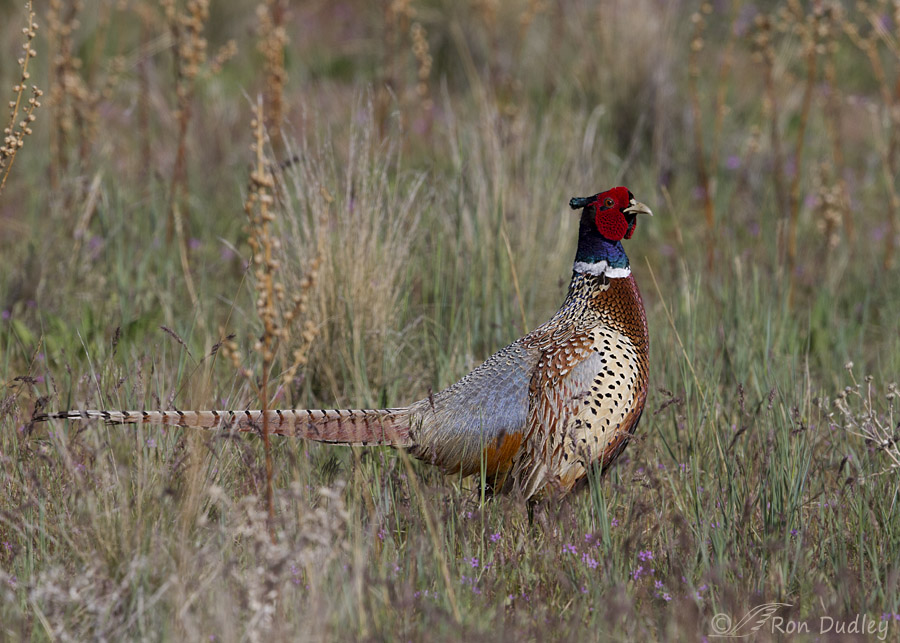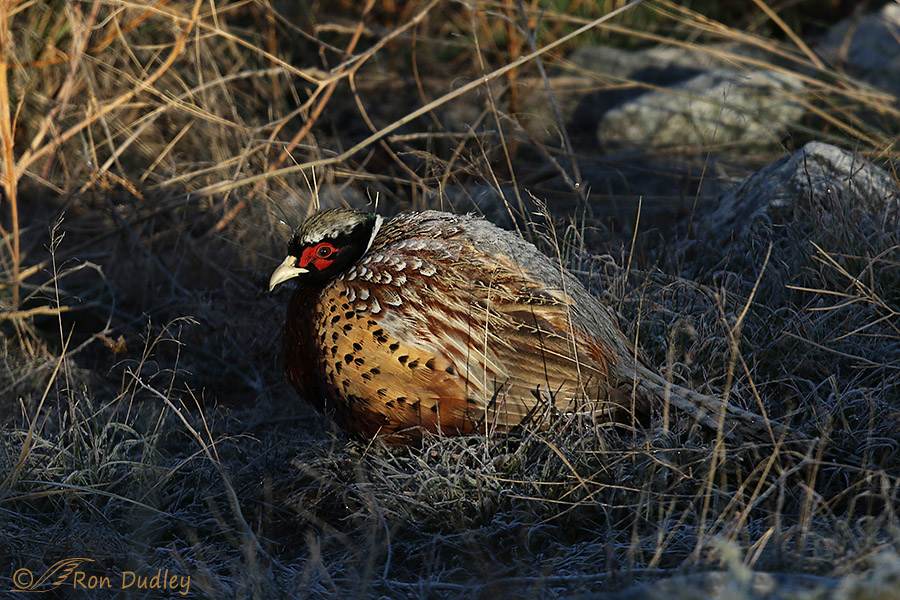I was struck by the contrast in attitude and demeanor between these adult male Ring-necked Pheasants.

1/3200, f/6.3, ISO 500, Canon 7D, Canon EF500mm f/4L IS II USM, not baited, set up or called in
I photographed this striking bird at Bear River Migratory Bird Refuge on May 20 of this year. He was alert, his posture proud, his colors brilliant and his bright red wattles were fully on display in the purple flower-studded splendor of his springtime habitat.

1/800, f/10, ISO 500, Canon 7D Mark 2, Canon EF500mm f/4L IS II USM, full-frame image taken and processed in JPEG, not baited, set up or called in
But this second bird wasn’t looking quite so cocky. I photographed him just at dawn two mornings ago at Farmington Bay Waterfowl Management Area when it was only 21 degrees F. The back of the pheasant is covered with frost and I strongly suspect that this secluded spot in a depression is where he spent the night. He was fluffed up in the cold and barely moved a feather in the minute or so I photographed him.
We’re in the midst of pheasant hunting season and this area is often trammelled by hunters and their dogs so perhaps very recent encounters with hunters contributed to its demeanor but I doubt it.
I think the bird was just cold.
Ron


As Elephant’s Child wrote, maybe it is, indeed, a bit of both? We all see the differences in behavior between birds in hunted and non-hunted areas. And here in the PNW, the Snow Geese seem to almost know, to the day, when the season is over. They become more approachable and visibly more calm. Or maybe it’s just that I am more calm, not having to hear and see the shooting anymore, and I’m filtering their experience through my own. 🙂
Perhaps a combination of the cold and the hunters and their dogs? Life as a game bird (hiss and spit) is hard enough without adding the weather into the equation.
Beautiful shots of these stunning birds.
Wow-In the first ( stand-up male )-I don’t think I’ve ever seen such full coloring, including the iridescences , captured in a single exposure–thrilling ! The second image was a good reminder of the
realities of life for a wild creature , an interesting juxtaposition with the first image .
Brrrrrr I know how he feels. It’s 13 here in eastern New Mexico where I’m visiting:)
Stephanie, We’re supposed to have snow this morning but so far the forecasters miserable accuracy record is holding and not a flake…
Ron – these birds are easily seen in a state park not far from my home. Believe it or not – the best place to see them is right next to the gun shooting range in the park. Go figure!
Wow, brave birds, Mark. Or perhaps they’ve learned that actual hunting is not allowed adjacent to the shooting range…?
Wonderful shots! I know just how the one that’s hunkered down feels.
Charlotte
So do I, Charlotte. It comes with the territory when you grow up in Cut Bank, Montana. Thank you.
Great shots Ron.
I grew up with Ring-necks in a field in back of our house. Of course in the 1930’s there was a ton of open space compared to today.
What will it be like 25-50 years from now?! It has been years since I’ve seen one in the wild.
Dick, Over the years our pheasant habitat has been significantly diminished, largely due to urban sprawl taking over agricultural lands but there’s still a fair number of them if you know where to look.